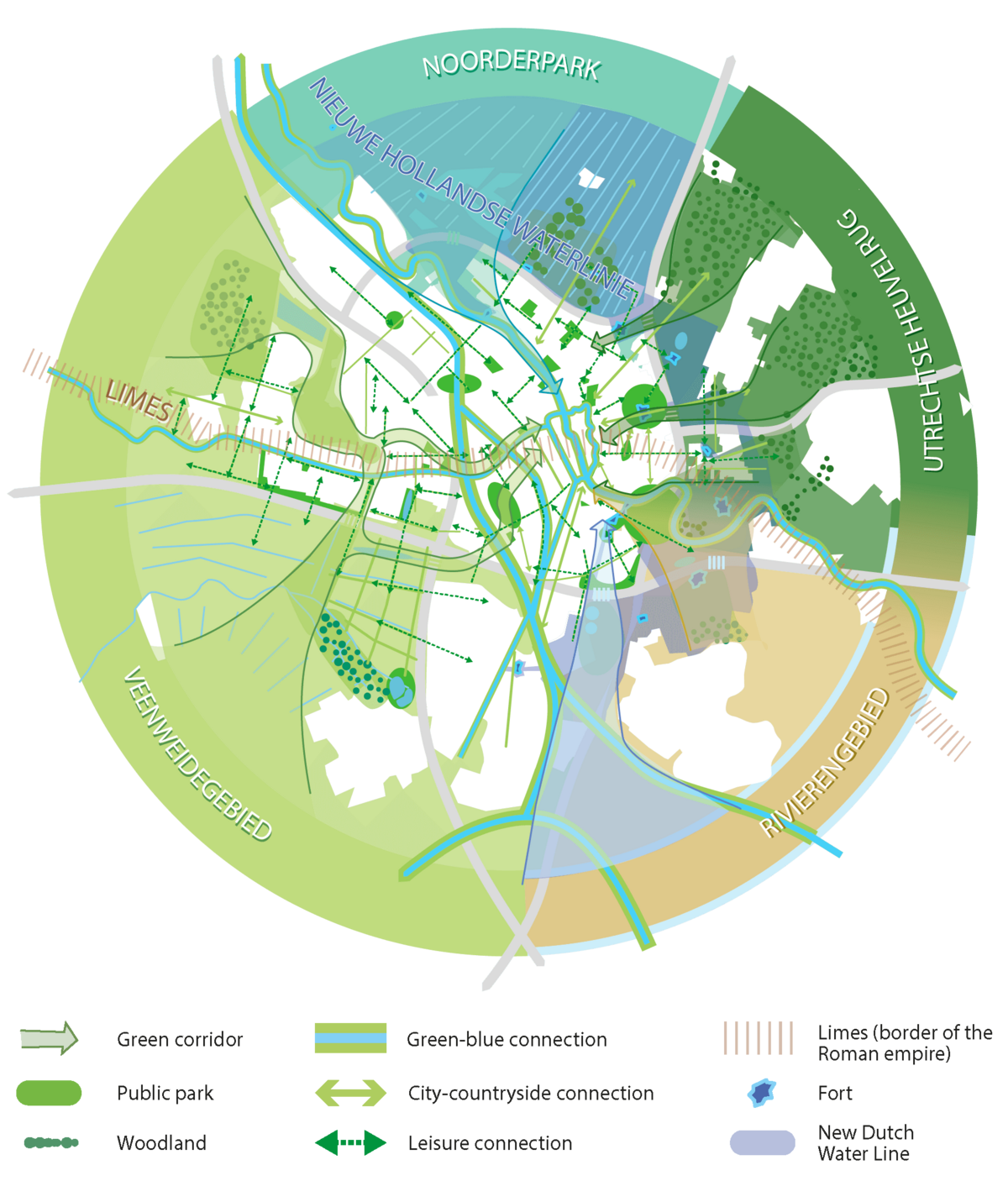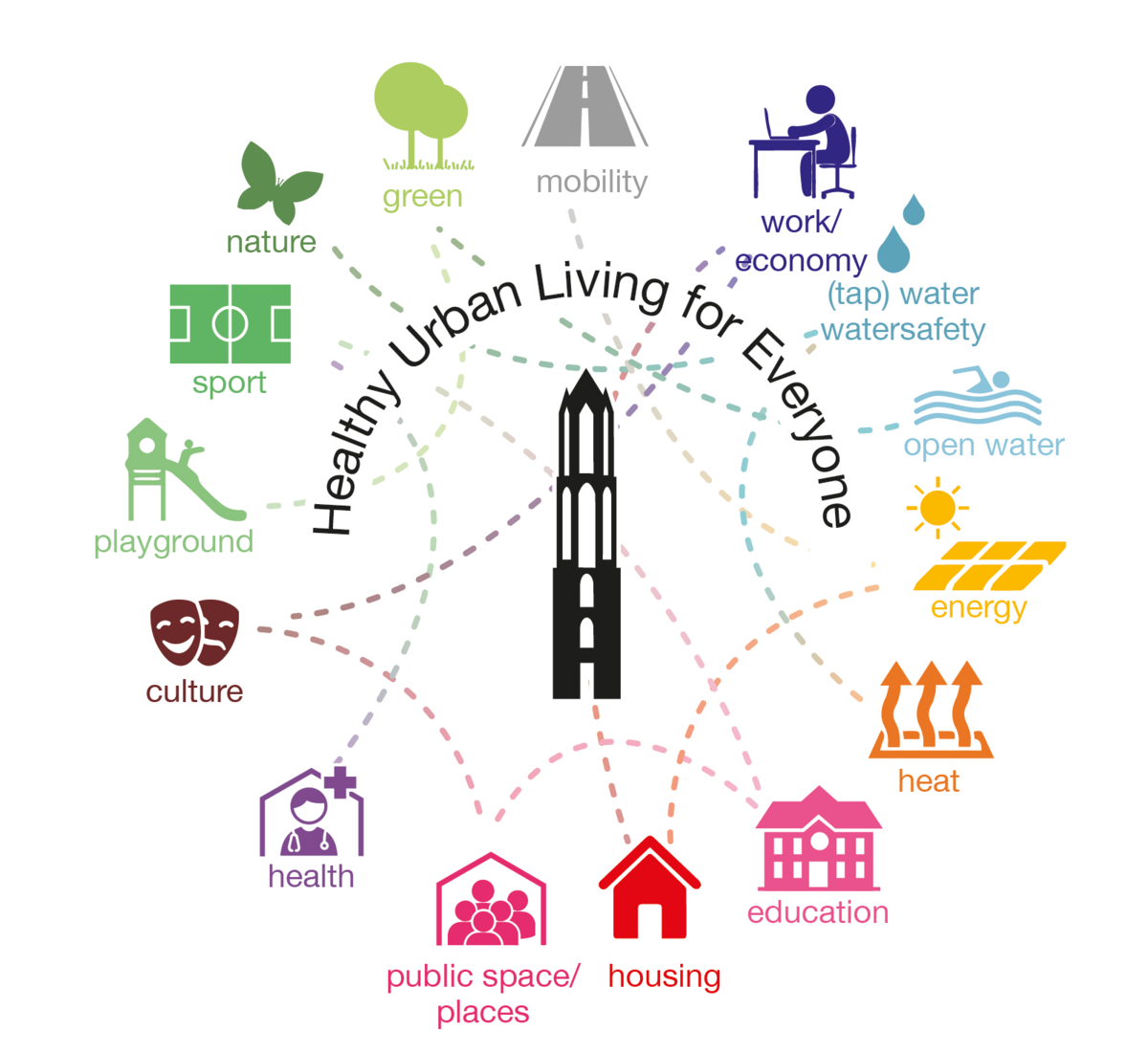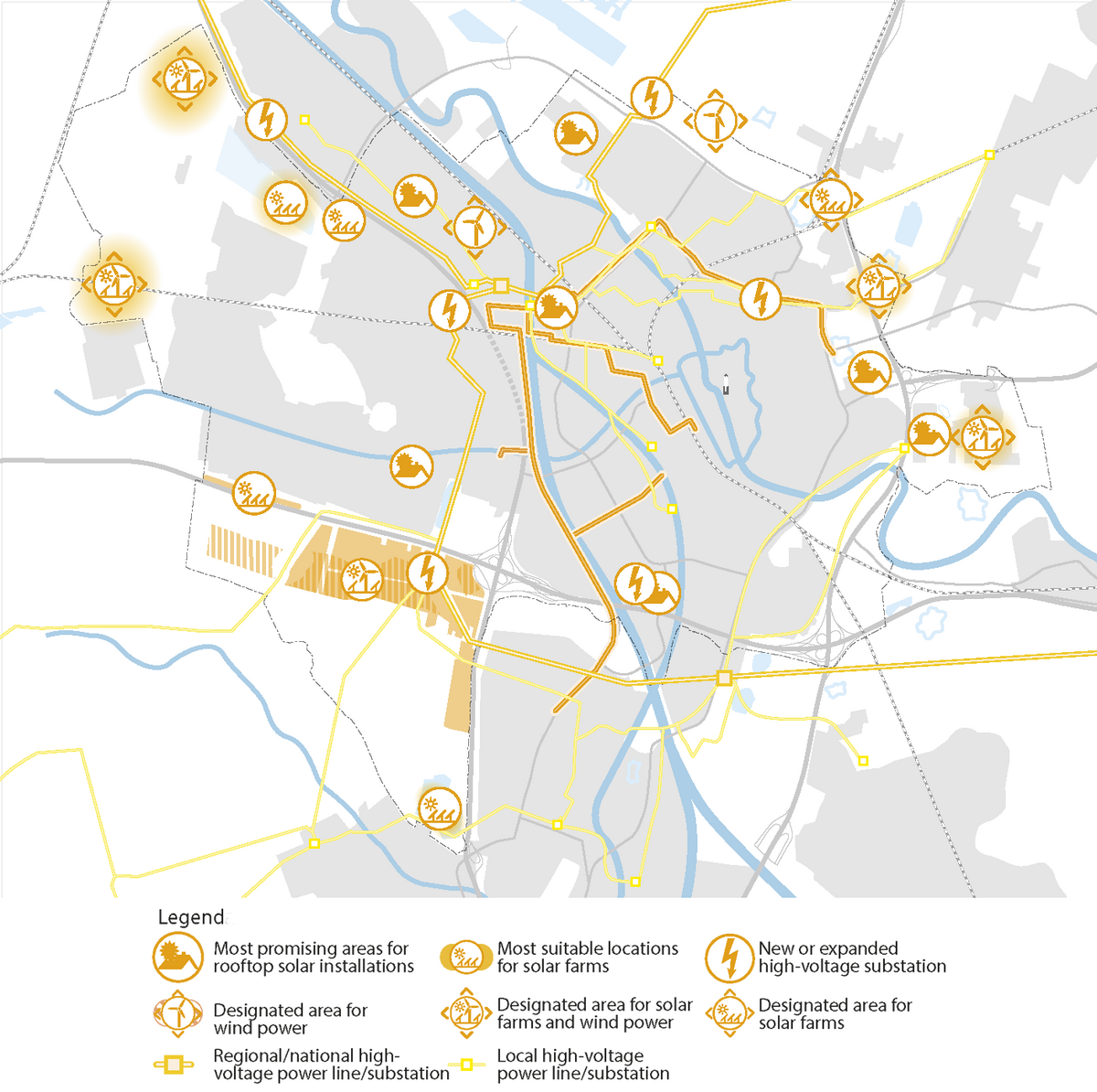Our vision for Utrecht in 2040
Utrecht is growing and preparing for the future. The number of people living in our city is on the rise: Today, 350,000 people call Utrecht home, and in 20 years’ time, that number will grow to around 455,000. We want to make sure that our city is a healthy and enjoyable place for these people to live and work. We also want to make sure that they can travel across, in and out of the city quickly and easily, and have plenty of things to do in their spare time. To help us deliver on these promises, we need to make choices now.
We are building on the qualities of our city
Utrecht will always be a beautiful city with a lot going on. A city teeming with history. A city that has everything you need close by. A city surrounded by varied landscapes. A city of knowledge with well-educated people. A city with businesses and schools that keep moving forward. A city at the heart of the country's transport networks. We intend to keep it that way. Our history and surroundings are the foundations upon which we build. At the same time, we are moving towards a new future. We are building affordable homes in a healthy, green environment, with easy access to the city and beyond, and healthcare nearby. The Dutch Water Line is set to become our new city wall, and we will build new landmarks to represent our city like the Dom Tower does today.

We intend to bring the varied landscape around Utrecht closer to the city by adding more woodland, parks and water. Greenery is always nearby.
The map shows 4 landscapes:
- veenweidegebied (west)
- Noorderpark (north)
- Utrechtse Heuvelrug (east)
- Rivierengebied (southwest)
2 historical structures:
- Nieuwe Hollandse Waterlinie
- Romeinse limes (through Leidsche Rijn en the city centre)
Parts of the city are connnected, and the city is connected with the environment:
- recreational connections (walking- en cycling routes)
- green and water connection, like parks, canals, rivers, channels)
Forests nearby the city:
- northeast side (Utrechtse Heuvelrug)
- Haarzuilens
- Noorderpark
- Utrecht Science Park
- Houten
- IJsselstein
We are creating more greenery and water
Because greenery and water are important. They provide a healthy and pleasant environment in which people can relax and exercise. They make sure that it does not get too hot, too dry or too wet in the city as the climate changes. As such, it is key to find the perfect balance between homes and nature as our city continues to grow. Historical green spaces and waterways are at the core of our plans, but we are also making our streets greener and creating new parks. We are allowing grass to grow on tram tracks, and we are making sure that people can enjoy our waterways. We are creating new natural spaces all around the city, and making sure it is easy to get.
We are creating new hubs
Downtown Utrecht will always be the heart of our city. However, if everyone and everything needs to be there, it will get far too busy. To ease the load, we are creating urban centres in other locations around the city. We call these centres hubs. A hub is a place where multiple roads and public transport connections intersect, as well as a place where we can build more homes, amenities, offices and healthcare centres. The new hubs are Central Leidsche Rijn, Papendorp, Westraven, Lunetten-Koningsweg, Overvecht and the Utrecht Science Park (the area around the university). Near Utrecht Central Station, we are encouraging development around Beurskwartier, Jaarbeurs, along the Merwede Canal and in the Cartesius Triangle. Other areas will see changes too, albeit on a smaller scale than the hubs.

We are working in a fixed order
We are starting with the hubs. Once those are complete, we will build at other locations in the city and on the outskirts, making sure public space and greenery are preserved. Lastly, we will build outside the city as we know it today.
We are using our space smartly
If you live in our city, the first thing you need is a place to call home. Once you have that, you want to be able to go shopping, exercise, enjoy the nature, go to the theatre, have electricity and an Internet connection and move around easily. All of these things require space: cycle lanes, footpaths, roads, parks, sports fields, shops, cables, schools and theatres. If you put all these elements next to one another, you will end up with something that resembles a barcode. That’s exactly what we are calling it: the barcode for the development of our city.
The barcode helps us decide how best to use the limited amount of space available. Do we build at ground level? Do we build underground? Or do we build upwards? We are also making sure that buildings and public space are used for multiple purposes. Buildings that have shops at ground level, offices above, and homes higher up. Homes that are suitable for working from home. Noise barriers that double as solar cells. Sports fields that can also serve as a space to temporarily store water. And buildings that house schools, gyms, offices, homes, shops, healthcare practices and theatres. We are bringing more life to our neighbourhoods and reducing the need to travel.
All of this helps us turn Utrecht into the ‘10-minute city’
In our city, everyone and everything you need is close by. Whether you are walking, cycling or travelling by public transport, you can get to where you need to be in no time.

To make this possible, we are working on an excellent transport network
We are prioritising clean ways to travel that take up less space, such as walking, cycling and public transport. Our goal is to give you different options to get to where you need to be. Needing less space to move people also allows us to use the remaining space differently. It can become public space, for example, where you can spend time alone or with others.
We are creating a public transport ring around our city to help inhabitants and visitors travel quickly and comfortably. With a ring around the city, many travellers will no longer need to pass through Utrecht Central Station. The network will connect the different hubs to one another. When you arrive at a hub, you will easily be able to switch trains or trams, or continue by bike or shared car/bike. There will be plenty of opportunities to live and work around the hubs. Fast and comfortable buses, trams and trains will connect the Utrecht region and the rest of the Netherlands to the national hub at Utrecht Central Station.

This map shows how and in which locations the public transport network will be expanded. Aside from Utrecht Central Station, we intend to create other hubs, as well as a transport ring between them.
There will be public transport between:
- station Leidsche Rijn-centrum
- station Zuilen
- winkelcentrum Overvecht
- station Overvecht
- Rijnsweerd
- Utrecht Science Park
- Galgenwaard
- station Lunnetten-Koningsweg
- Westraven
- Papendorp
- station Leidsche Rijn-centrum
There will be bus/tram connection between:
- Utrecht centraal – winkelcentrum Overvecht – Overvecht-Noord
- Utrecht centraal - Nieuwegein/IJsselstein via Merwedekanaalzone
- Utrecht centraal - Papendorp via Kanaleneiland
- Utrecht Science Park – Zeist (en verder richting Amersfoort) langs A28
There are good train connections between Utrech and Rotterdam, Den Haag, Amsterdam, Almere, Hilversum, Amersfoort, Zwolle, Arnhem, Den Bosch, Eindhoven, Breda.
We are connecting the city and the surrounding landscape
We are removing as many obstacles as possible from the environment around the city to connect the city and the green landscape. We are not stopping there. We are removing obstacles in the city too, allowing people to walk or cycle through long stretches of greenery. These changes will help us bring the landscape around the city closer to your front door, while making the city more resistant to climate change at the same time. To start with, until 2035, the Rijnenburg polder will be used to generate energy and as a space to exercise, relax and spend time in nature. If we need to build in this area after 2035, we will make sure we create a sustainable neighbourhood with room for work, sports, culture and leisure.
We are making Utrecht an even more inclusive city
Because Utrecht belongs to all of us. Everyone in Utrecht is part of our city and can get involved. If all inhabitants, organisations and businesses join forces, we can make Utrecht an even better place. We are working together to create a healthy and enjoyable city; a city where everyone is welcome and feels welcome, and where everyone can take part in society. Regardless of whether you are rich or poor, employed or unemployed, disabled or need care.
A city where everyone can get and afford a home, an education, a job and the amenities they need. A city where buildings and public space provide an inviting setting for people to meet and stay in touch. To do so, we are removing boundaries and obstacles, and making sure there is a better range of homes on offer, both in terms of quantity and quality. We are creating a city where rented homes sit side by side with owner-occupied homes, and luxury homes sit side by side with affordable homes.
We are going for sustainable energy
Our energy needs will grow with the number of inhabitants, visitors and businesses in our city. At the same time, we need to make sure that our CO₂ emissions keeps going down. To achieve both of these goals, we are saving energy, and generating more sustainable power. We are making increasing use of solar power, wind power, geothermal energy and residual heat from businesses. We are developing alternative heat supplies for homes and buildings, enabling the transition away from natural gas.

Most promises areas for rooftop solar installations:
- Lage Weide
- Bedrijventerrein Overvecht
- Bedrijventerrein Cartesius
- Oudenrijn
- Kanaleneiland-Zuid
- Utrecht Science Park
- Rijnsweerd
Most suitable locations for solar farms:
- Haarrijnseplas
- De Wetering-Noord
- Geluidswal A12 near Veldhuizen
- Nedereindse Plas
Designated area for solar farms:
- A27 near Blauwkapel
Designated area for solar farms en wind power:
- Ockhuizen (Thematerkade)
- Bijleveld
- Rijnenburg en Reijerscop
- Utrecht Science Park
- Biltse Rading
Designated area for wind power:
- Lage Weide
- Noorderpark
New or expanded high-voltage substation:
- A2 near Maarssenbroek
- Leidsche Rijn Centrum-Noord
- Rijnenburg
- Kanaleneiland-Zuid
- Kardinaal De Jongweg
- near Fort de Gagel
We are working to create jobs for everyone
In the future, employers will expect a different kind of knowledge and experience from their employees. We need to prepare for this, as work matters to people. There are four sectors in Utrecht that offer a lot of jobs now and will continue to do so in the future: ICT, healthcare, education and construction. That is exactly where our focus will be.
We are doing it step by step
We cannot transform our city all at once, as it needs to remain an attractive place to be while the work is ongoing. Life needs to stay good in Utrecht, even as the city is changing around us. The quality of what we build will also be higher if we take things slow. We are also keeping a close eye on the order in which we do things, making sure the work that needs to be done in the early stages is done properly, before moving on to the next stage. We are starting with the roads, as we need those to start building homes and offices as soon as possible.
We cannot do it alone
Nor do we want to. We want to work with you, the people of Utrecht; with entrepreneurs, organisations and other public authorities. Everyone can contribute their ideas on how to improve our city and make it more attractive. Together, we are working to create a healthy and enjoyable city.
Overall, our plans will cost around €7 billion, and we need help with that too. We are contributing some of this amount ourselves, but the rest has to come from elsewhere: the Province of Utrecht, national government, the European Union, businesses and inhabitants. The people or organisations who stand to gain the most from these developments will pay the most, so everyone contributes towards making our city more valuable.
Utrecht Spatial Strategy 2040
More detail on all these plans can be found in the Utrecht Spatial Strategy 2040 document (in Dutch). USS2040 is an outline document. It defines the conditions that must be met in the definitive plan for Utrecht’s future.

This image shows what a street looks like today (2021) and in 2040. In 2040, there is more greenery, water storage, less street, and more space to spend time.
Now and later
Utrecht in 2021
- little space for cyclists and pedestrians
- little space for greenery
- wide roads, 50 km/h speed limit
- parking dominates public space
- in the ground: water electricity, gas, mixed sewer system
Utrecht in 2040
- lots of space for cyclists and pedestrians
- a green view from every home
- shade in the streets
- shared mobility and electric vehicles
- narrow roads, 30 km/h speed limit
- space for greenery
- space to meet people
- space to excercise and play
- in the ground: water, new electricity grid, district heating system, seperate sewing systems, rainwater storage, underground waste collection
Assignments for the opproach of the public space
Mobility transition
- cycling scheme
- 30 km/h zones
- combined public transport
- out-of-town parking
- shared mobility
Greenery scheme
- extra public greenery
- green routes
- biodiversity
- green streets
Climate adaption
- heat stress
- flooding
- drought
Inclusivity
- accessibility
- space to meet
- excellent connections
- safety
Energy transition
- electric vehicles
- generate energy at home
- storage
- gasfree
Change street furniture
- Underground waste collection
- sustainable lighting
- smart cities


